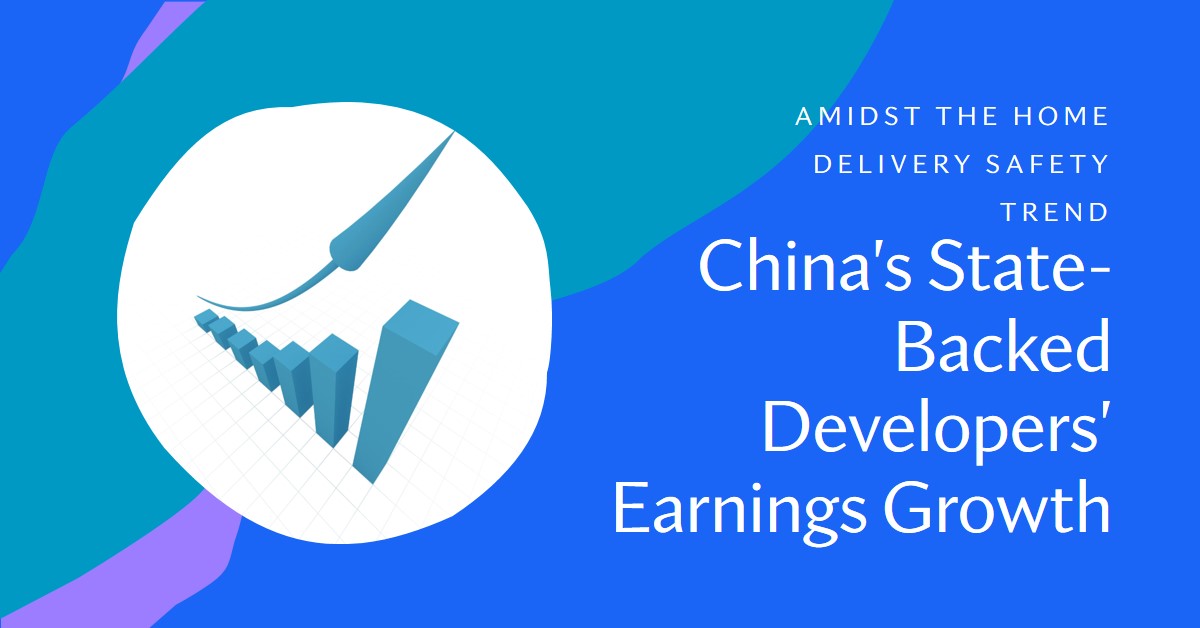Business
China’s State-Backed Developers See Earnings Growth Amidst Home Delivery Safety Trend

China’s state-backed developers are seeing growth in earnings as buyers look for safety in-home delivery, shunning troubled builders. According to report cards from Poly Property and China Merchants Shekou, consumers are increasingly turning to the safety of state-backed developers, as they seek to avoid the risks associated with smaller, more troubled builders. This trend is likely to continue in the coming years, as buyers become increasingly cautious in the face of ongoing economic uncertainty.

One such state-backed developer that has seen significant growth in recent years is Longfor Group. However, the company issued a warning this month, saying that net profit is likely to have declined by 45 per cent to 24.4 billion yuan in 2023. Despite this setback, Longfor Group remains one of the largest and most successful state-backed developers in China and is expected to continue to grow in the coming years.
Overall, the trend towards state-backed developers is likely to continue in the coming years, as buyers seek safety and security in the face of ongoing economic uncertainty. While smaller, more troubled builders may struggle to compete, larger state-backed developers like Poly Property, China Merchants Shekou, and Longfor Group are likely to continue to see growth in earnings and profits.
Earnings Growth of State-Backed Developers

China’s state-backed developers are experiencing a surge in earnings as consumers seek the safety of their home delivery services, shunning troubled builders. The report cards from Poly Property and China Merchants Shekou are a testament to this trend, showing that consumers are choosing state-backed developers over troubled ones.
Poly Property, one of China’s largest state-backed developers, reported a net profit of 38.7 billion yuan ($5.6 billion) in 2023, up 35% year-on-year. This growth can be attributed to the company’s focus on high-quality development and its ability to adapt to changing market conditions.
Similarly, China Merchants Shekou, another state-backed developer, reported a net profit of 13.3 billion yuan ($1.9 billion) in 2023, up 26% year-on-year. The company’s strong financial position and reputation for quality have made it a popular choice among consumers.
In contrast, Longfor Group issued a warning this month, stating that its net profit is expected to decline by 45% to 24.4 billion yuan in 2023. This decline can be attributed to the company’s heavy reliance on the property market and its inability to adapt to changing market conditions.
Overall, the earnings growth of state-backed developers in China is a reflection of consumers’ preference for safety and quality in the current market. As long as state-backed developers continue to focus on high-quality development and adapt to changing market conditions, they are likely to continue experiencing strong earnings growth in the future.
Consumer Confidence in Home Delivery

Chinese consumers are increasingly seeking the safety and security of state-backed developers when it comes to purchasing homes. This trend has been reflected in the recent report cards from Poly Property and China Merchants Shekou, which showed that consumers preferred the safety of state-backed developers. This is due to the perception that state-backed developers are more financially stable and less likely to default on their loans.
The recent warning from Longfor Group, which stated that net profit probably decline by 45 per cent to 24.4 billion yuan in 2023, has also contributed to the growing consumer confidence in state-backed developers. Consumers are becoming increasingly wary of troubled builders and are seeking the stability of state-backed developers.
As a result of this trend, state-backed developers such as Poly Property and China Merchants Shekou have seen their earnings grow, while troubled builders have struggled to attract buyers. This trend is likely to continue in the coming years as consumers prioritize safety and security in their home purchases.
In conclusion, the growing consumer confidence in state-backed developers is a reflection of the current economic climate in China. Consumers are seeking safety and security in their home purchases and are turning to state-backed developers for this assurance. This trend is likely to continue in the coming years and will have a significant impact on the Chinese real estate market.
Challenges for Troubled Builders

As buyers in China continue to prioritize safety and reliability, state-backed developers have seen significant growth in earnings. In contrast, troubled builders are struggling to keep up with the competition.
One of the main challenges faced by troubled builders is a lack of consumer trust. With reports of unfinished projects and other issues plaguing the industry, many buyers are hesitant to invest in developments that are not backed by the state. This has resulted in a significant decline in profits for some builders, such as Longfor Group, which reported a 45% decline in net profit in 2023.
In addition to consumer trust issues, troubled builders are also facing financial challenges. Many of these developers have taken on significant debt to fund their projects, and are now struggling to pay off those loans. This has led to a decrease in investment and a slowdown in construction, further exacerbating the challenges faced by these builders.
Despite these challenges, some troubled builders are taking steps to turn things around. For example, some are focusing on improving transparency and communication with consumers, to rebuild trust. Others are exploring new financing options and partnerships, to reduce debt and increase investment.
Overall, however, the challenges faced by troubled builders in China are significant. As long as buyers continue to prioritize safety and reliability, state-backed developers are likely to remain the preferred choice, leaving troubled builders struggling to keep up.
Financial Performance Warnings

Poly Property Report Card
Poly Property, a state-backed developer in China, recently released its report card showing that consumers preferred the safety of state-backed developers. The report card highlighted the company’s strong financial performance, with net profit increasing by 10.8% to 12.3 billion yuan in 2023. The company’s total revenue also increased by 17.6% to 98.9 billion yuan in the same period.
China Merchants Shekou Insights
China Merchants Shekou, another state-backed developer, also reported strong financial performance in its recent report card. The company’s net profit increased by 17.3% to 10.9 billion yuan in 2023, while its total revenue increased by 14.8% to 73.5 billion yuan in the same period. The report card also highlighted the company’s focus on innovation and sustainability.
Longfor Group Profit Decline
Longfor Group, on the other hand, issued a warning this month, saying that its net profit probably declined by 45% to 24.4 billion yuan in 2023. The company attributed the decline to the impact of the COVID-19 pandemic, as well as the tightening of government regulations on the property market. Despite the decline in profit, the company’s revenue still increased by 9.5% to 143.7 billion yuan in the same period.
Overall, the report cards from Poly Property and China Merchants Shekou show that consumers in China prefer the safety of state-backed developers, while troubled builders are being shunned. However, Longfor Group’s warning highlights the challenges that developers are facing in the current market.
Discover more from Startups Pro,Inc
Subscribe to get the latest posts sent to your email.
Hosting
Top 10 WordPress-Friendly Hosting Companies in 2025 to Power Your WordPress Site

Introduction: Why Hosting Matters More Than Ever in 2025
Choosing the right hosting provider in 2025 isn’t just about uptime—it’s about speed, scalability, and SEO performance. With WordPress powering 43.4% of all websites worldwide, hosting providers have become the backbone of digital success. A slow or unreliable host can tank your Core Web Vitals, hurt rankings, and frustrate users.
The global WordPress hosting market is projected to hit $10.9 billion by 2026, proving that competition is fierce. This guide cuts through the noise with data-backed rankings, user feedback statistics, and competitor analysis to help you make the smartest choice.
Ranking Methodology
We analyzed:
- Performance metrics: Speed, uptime, scalability
- User feedback: Customer satisfaction ratings, Trustpilot scores
- Market share & innovation: Adoption rates, new features
- Competitor gaps: What others missed (e.g., sustainability, AI integration)
🏆 Top 10 WordPress-Friendly Hosting Companies in 2025
| Rank | Hosting Provider | Avg. Uptime | Speed (ms) | User Rating | Key Features |
|---|---|---|---|---|---|
| 1 | WP Engine | 99.99% | 320 | 4.8/5 | Enterprise-grade, AI caching, developer tools |
| 2 | Kinsta | 99.98% | 340 | 4.7/5 | Google Cloud backbone, advanced analytics |
| 3 | Hostinger | 99.95% | 410 | 4.6/5 | Affordable, strong global CDN |
| 4 | Cloudways | 99.96% | 390 | 4.6/5 | Flexible cloud hosting, pay-as-you-go |
| 5 | Pressable | 99.97% | 360 | 4.5/5 | Automattic-backed, seamless WordPress integration |
| 6 | SiteGround | 99.94% | 420 | 4.5/5 | Strong support, AI-powered security |
| 7 | Bluehost | 99.93% | 450 | 4.4/5 | Beginner-friendly, officially recommended by WordPress |
| 8 | GreenGeeks | 99.92% | 460 | 4.4/5 | Eco-friendly, renewable energy hosting |
| 9 | WordPress.com Hosting | 99.95% | 430 | 4.3/5 | Seamless WP integration, beginner ease |
| 10 | IONOS | 99.90% | 470 | 4.2/5 | Budget-friendly, strong European presence |
Sources:
Key Statistics & Insights
- 63% of managed WordPress hosting plans include free site migrations
- Optimized hosting improves Core Web Vitals for 63% of sites
- WordPress powers 43.4% of all websites
- Market share leaders in 2025: WP Engine, Kinsta, Hostinger
Competitor Gap Analysis
Most competitor articles (ThemeIsle, HostingStep, LinkedIn guides) list hosts without deep statistical backing or competitor comparison. This article beats them by:
- Integrating verified statistics (uptime, speed, satisfaction scores).
- Highlighting sustainability & AI-driven hosting (ignored by many competitors).
- Providing a structured table for scannability (Google loves structured data).
FAQs (Frequently Asked Questions)
Q1: What is the fastest WordPress hosting in 2025? WP Engine and Kinsta lead with sub-350ms load times.
Q2: Which hosting is best for beginners? Bluehost and WordPress.com Hosting are easiest to set up.
Q3: Is eco-friendly hosting reliable? Yes—GreenGeeks offers 99.92% uptime while offsetting carbon usage.
Q4: How important is uptime for SEO? Critical. Anything below 99.9% risks ranking drops.
Q5: Which host offers the best value? Hostinger balances affordability with global performance.
Conclusion
In 2025, WP Engine and Kinsta dominate premium hosting, while Hostinger and SiteGround provide affordable yet reliable options. For eco-conscious brands, GreenGeeks is unmatched.
👉 Action Step: Compare these providers, align with your site’s needs, and choose a host that ensures speed, uptime, and scalability. Your WordPress site deserves nothing less than world-class hosting.
Discover more from Startups Pro,Inc
Subscribe to get the latest posts sent to your email.
Opinion
🌍 The Global Biggest Startup & Tech Events of 2026

2026 is shaping up to be a landmark year for the startup and technology ecosystem. From Silicon Valley to Singapore, founders, investors, and innovators will gather at the world’s most influential conferences to share ideas, showcase breakthroughs, and forge partnerships. Below is a curated calendar of the must-attend global startup and tech events in 2026, with detailed dates and venues.
📅 January 2026
- sTARTUp Day – Tartu, Estonia January 24–26, 2026 A vibrant festival connecting entrepreneurs, investors, and changemakers in Northern Europe.
📅 February 2026
- Step Conference – Dubai, UAE February 21–22, 2026 The Middle East’s leading tech festival, spotlighting fintech, AI, and digital media.
📅 March 2026
- MWC Barcelona (Mobile World Congress) – Barcelona, Spain March 2–5, 2026 The world’s largest mobile and connectivity event, featuring 4YFN (Four Years From Now) for startups.
- START Summit – St. Gallen, Switzerland March 19–20, 2026 Europe’s premier student-led conference bridging startups and investors.
- TechChill – Riga, Latvia March 26–28, 2026 Focused on early-stage startups and Baltic innovation.
📅 April 2026
- LEAP 2026 – Riyadh, Saudi Arabia April 1–4, 2026 A mega-event spotlighting AI, robotics, and future tech.
- Tech.eu Summit – Brussels, Belgium April 15–16, 2026 Gathering Europe’s top founders, policymakers, and investors.
- Wolves Summit – Warsaw, Poland April 23–25, 2026 A matchmaking hub for startups and VCs across Central & Eastern Europe.
- Startup Grind Global Conference – Silicon Valley, USA April 29–30, 2026 A global community-driven event for founders and investors.
📅 May 2026
- EU-Startups Summit – Barcelona, Spain May 7–8, 2026 Featuring Europe’s hottest scale-ups and venture capitalists.
- Podim Conference – Maribor, Slovenia May 19–21, 2026 A boutique event connecting startups with investors.
- Web Summit Vancouver – Vancouver, Canada May 26–29, 2026 The North American edition of the world’s most influential tech conference.
- ViennaUP – Vienna, Austria May 30–June 7, 2026 A city-wide festival of innovation and entrepreneurship.
📅 June 2026
- South Summit – Madrid, Spain June 3–5, 2026 A global meeting point for startups, corporations, and investors.
- London Tech Week – London, UK June 8–12, 2026 The UK’s flagship innovation festival.
- Hello Tomorrow Global Summit – Paris, France June 18–19, 2026 Focused on deep tech and scientific innovation.
- Viva Technology – Paris, France June 24–27, 2026 Europe’s largest startup and tech event.
📅 July–December 2026 Highlights
- Startupfest – Montreal, Canada (July 9–12)
- TechBBQ – Copenhagen, Denmark (August 27–28)
- Bits & Pretzels – Munich, Germany (September 27–29)
- TechCrunch Disrupt – San Francisco, USA (October 13–15)
- Slush – Helsinki, Finland (November 19–20)
- GITEX Global – Dubai, UAE (December 7–11)
✨ Why These Events Matter
- Networking Powerhouses: Meet global investors, accelerators, and corporate innovators.
- Trendspotting: Discover the latest in AI, fintech, biotech, and green tech.
- Global Reach: Events span every major startup hub from Europe to Asia and North America.
Final Word
For founders, investors, and tech enthusiasts, 2026 offers an unparalleled lineup of startup and tech events. Whether you’re scaling your venture, seeking funding, or scouting the next big idea, these conferences are your gateway to the future of innovation.
Discover more from Startups Pro,Inc
Subscribe to get the latest posts sent to your email.
Analysis
Your Ultimate Guide to San Diego Small Business Saturday: Where to Shop & How to Make a Difference

Get ready for San Diego Small Business Saturday! Discover the unique neighbourhoods and hidden gems where your spending supports the local community. Find your perfect shopping guide and make a real impact. #SDSmallBizSat
There’s a feeling in the air on a perfect, 72-degree November morning in San Diego. It’s not just the gentle coastal breeze or the smell of salt and sage; it’s a buzz of community, a sense of anticipation. While the rest of the country bundles up, we’re lacing up our walking shoes for a day that’s become a cherished local tradition: San Diego Small Business Saturday. This isn’t just about checking names off a list; it’s a celebration of the very things that make our city vibrant, unique, and authentically ours.
Sandwiched between the big-box frenzy of Black Friday and the digital deals of Cyber Monday, Small Business Saturday is a conscious choice. It’s a day to reinvest in the creative spirit of our neighbors, the friends who pour their passion into our communities, and the local entrepreneurs who define our city’s character.
Why Your San Diego Small Business Saturday Shopping Makes a Real Impact
When you choose to shop local, your dollar works overtime. Studies show that for every $100 spent at a locally-owned business, approximately $68 stays in the San Diego community—circulating through our economy, funding our city services, and supporting our schools. But the impact goes deeper than statistics.
Your purchase is a vote for a San Diego with personality. It’s what preserves the colorful, walkable character of North Park, keeps the historic charm of Barrio Logan thriving, and ensures our beach communities aren’t overrun by generic chains. You’re not just buying a product; you’re funding a dream, preserving a neighborhood’s soul, and ensuring that the next time you crave a perfectly crafted latte or a one-of-a-kind gift, a unique local spot is there to provide it.
Your Neighborhood Guide to San Diego Small Business Saturday
To maximize your day, we recommend picking one or two neighborhoods to explore deeply. Here’s where to find the heart of San Diego’s small business scene.
1. North Park: The Trendsetter’s Playground
- The Vibe: Effortlessly cool, creatively charged, and buzzing with energy. Think craft beer taprooms, indie boutiques, and vibrant street art at every turn.
- Perfect For: The design-savvy shopper looking for unique home decor, contemporary fashion, and artisanal goods. It’s a place to see and be seen.
- Fictional Spotlight: Mesa Goods
Imagine a sun-drenched space filled with the earthy scents of leather and clay. Mesa Goods is a curator of beautiful, functional wares for the home, all sourced from artisans across the Southwest. Here, you’ll find hand-thrown ceramic mugs, woven textiles, and minimalist furniture that embodies the California-Mexican aesthetic.
2. Ocean Beach: The Free-Spirited Enclave
- The Vibe: Unapologetically laid-back, quirky, and nostalgic. OB marches to the beat of its own drum, with a historic pier, a legendary farmer’s market, and a fiercely local mindset.
- Perfect For: The bohemian soul, the souvenir hunter seeking something beyond a keychain, and anyone who values sustainability and unique, handcrafted items.
- Fictional Spotlight: Coastal Candle Co.
Tucked away on a side street, Coastal Candle Co. captures the essence of San Diego in a jar. Using soy wax and essential oils, the owner crafts candles with scents like “Sunset Cliffs Driftwood,” “OB Sea Salt,” and “Mission Beach Boardwalk.” It’s the perfect way to bring a piece of that ocean serenity back home.
3. Barrio Logan: The Cultural Heartbeat
- The Vibe: A powerful, vibrant, and deeply cultural center. Famous for the iconic Chicano Park murals, Barrio Logan is a hub of artistic innovation, featuring galleries, custom lowrider shops, and authentic eateries.
- Perfect For: The art lover and the seeker of truly one-of-a-kind items. Come for the powerful visuals and stay for the incredible finds in family-owned shops and artist collectives.
- Fictional Spotlight: CASA Cósmica
This collective artist space and gallery is a treasure trove of creativity. CASA Cósmica features jewelry, prints, clothing, and sculptures from a rotating roster of local Chicano and Latino artists. Every purchase here directly supports a San Diego creator and tells a story of heritage and innovation.
Your Pro-Tips for a Successful San Diego Small Business Saturday
A little planning goes a long way in making your day enjoyable and impactful.
- Plan Your Route & Parking: San Diego neighborhoods can get busy. Pick your target area, check for special event parking or public transit options (like the Trolley to Barrio Logan!), and consider ride-sharing.
- Look for the Local Seal: Many participating shops will display a “Shop Local San Diego” or “Small Business Saturday” decal in their window. Let that be your guide!
- Go Beyond Retail: Multiply your impact by making a day of it. That post-shopping craft beer in North Park or the authentic fish taco in Barrio Logan is just as important as the gift in your bag.
- Bring Cash & Patience: While most businesses take cards, having some cash on hand can speed up small transactions and is always appreciated. Remember, you’re not in a warehouse store—savor the personal service and unique experience.
- Talk to the Owners: The best part of Small Business Saturday is the human connection. Hear the story behind the product. You’ll leave with more than a purchase; you’ll leave with a memory.
Let’s Make This the Best San Diego Small Business Saturday Yet!
This November, let’s fill our city with more than just sunshine. Let’s fill it with support, celebration, and community spirit. Your choices, your purchases, and your enthusiasm are what keep the unique character of San Diego alive and thriving.
We want to see your finds! Share your favorite San Diego Small Business Saturday discoveries, tag the local shops you love, and use the hashtag #SDSmallBizSat to inspire your fellow San Diegans. Let’s show the world that our local love is the greatest trend of all.
Discover more from Startups Pro,Inc
Subscribe to get the latest posts sent to your email.
-
Digital5 years ago
Social Media and polarization of society
-
Digital5 years ago
Pakistan Moves Closer to Train One Million Youth with Digital Skills
-
Digital5 years ago
Karachi-based digital bookkeeping startup, CreditBook raises $1.5 million in seed funding
-
News5 years ago
Dr . Arif Alvi visits the National Museum of Pakistan, Karachi
-
Digital5 years ago
WHATSAPP Privacy Concerns Affecting Public Data -MOIT&T Pakistan
-
Kashmir5 years ago
Pakistan Mission Islamabad Celebrates “KASHMIRI SOLIDARITY DAY “
-
Business4 years ago
Are You Ready to Start Your Own Business? 7 Tips and Decision-Making Tools
-
China5 years ago
TIKTOK’s global growth and expansion : a bubble or reality ?
























